The Technology Acceptance of a TV Platform for the Elderly Living Alone or in Public Nursing Homes
Abstract
:1. Introduction
1.1. Background
1.2. Seniors and Interactive TV
- Seniors are a broad group with a high level of TV program consumption but little or no access to the information society.
- Seniors are a group with more free time, which is mainly used to read news or watch TV.
- Preventive medicine.
- Dietary treatments (cholesterol, diabetes, cardiovascular problems).
- Formative programming content with interaction from the elders.
- Electronic payments (useful for the groups that are not used to the Internet).
- Entertainment.
- Serious gaming (to support cognition).
2. Methods
2.1. User Centered Design
- Specify the usage context: Identify people that will use the product, what their goals are in using it, and under which circumstances they will use it.
- Specify requirements: Identify all the requirements and the users’ objectives that are needed for success with the product.
- Produce design solutions: This part must follow an iterative process, starting from a low fidelity prototype to a high-fidelity prototype.
- Evaluation: This stage must be (ideally) executed through tests with real users; this is the most important part of the process.
2.2. Usage Context and Requirements
- Take longer to learn new applications or devices.
- Take longer to complete tasks.
- Use different search strategies.
- Perform worse on tasks relying on memory.
- Be more distractible.
- Have a harder time dealing with errors.
- Make more erratic or accidental movements with the pointer.
- Make more input errors.
- Have more trouble hitting on-screen targets.
2.3. Design and Requirements
- Minimize the number of steps: As the Human-TV Interaction system is mainly operational through a remote control and can be exasperating, we minimized the number of steps from the home screen to reach a given screen.
- Use consistency: iTVCare offers the same set of options in the same order to facilitate recognition.
- Reduce the information presented: Memory impairment means that elderly people need interfaces with no irrelevant information.
- Clear indication of the current screen: As mentioned, memory impairment makes older adults more susceptible to getting lost in the application.
- Use meaningful icons and labels: Because older adults are more likely to have vision problems, graphic symbols are beneficial so that the users do not need to struggle with words.
- Use a very large font type;
- Use an easy to read font family;
- Use mixed case;
- Leave plenty of space;
- Present few calls to action;
- Design error messages to be clear;
- Make it easy to correct input errors;
- Avoid the use of scroll;
- Use high contrast between elements of the user interface.
- iTVCare: This layer represents the home system of the user, where the Google TV is installed.
- Database: This component stores information for medical appointments and medicine intakes.
- Television with Google TV: The television requires a device in charge of the reception and decoding of the TV signal, and the execution of the interactive applications that will be displayed on the television. This device is known as a set-top-box (STB).
- Android SDK: Contains the development tools that enable developers to create these applications, and the STB to execute the applications.
- Services: The services layer includes the components to be consumed by iTVCare.
- Medication intake: This component manages users’ medicine intakes, and generates alerts when it is time for a new intake.
- Medical appointments: This component manages appointments with doctors.
- Management: Finally, users will receive the information visually from the television and interact with the applications using the remote control and a keyboard. The users can be both older adults and their caregivers.
2.4. Evaluation
2.4.1. Participants and Recruitment
2.4.2. The Intervention
3. Results
3.1. Related to Interactive TV
- Name of medication.
- Dose.
- Frequency of drug intake.
- Treatment duration.
- First intake.
- Name of appointment.
- Address.
- Date.
- Time.
- Additional information.
3.2. Related to the Usage of the System
3.3. Users Interviews
- Q1.
- What are the most important aspects of iTVCare?
- Q2.
- What are the main problems of iTVCare?
- Q3.
- Do you have other observations or suggestions for iTVCare?
4. Discussion
5. Limitations and Future Work
6. Conclusions
Acknowledgments
Author Contributions
Conflicts of Interest
Appendix A
| Subscale | Item | Measure Scale | ||||||
|---|---|---|---|---|---|---|---|---|
| Perceived ease of use (Ease of use) | I would find iTVCare easy to use | 1 | 2 | 3 | 4 | 5 | 6 | 7 |
| Learning to operate iTVCare would be easy for me | 1 | 2 | 3 | 4 | 5 | 6 | 7 | |
| My interaction with iTVCare would be clear and understandable | 1 | 2 | 3 | 4 | 5 | 6 | 7 | |
| It would be easy for me to me to become skillful at using iTVCare | 1 | 2 | 3 | 4 | 5 | 6 | 7 | |
| Perceived usefulness (Usefulness) | Using iTVCare would enable me to accomplish tasks (medicine intake reminders and medical appointments) more quickly | 1 | 2 | 3 | 4 | 5 | 6 | 7 |
| Using iTVCare would improve my performance (medicine intake reminders and medical appointments) | 1 | 2 | 3 | 4 | 5 | 6 | 7 | |
| Using iTVCare would increase my productivity (medicine intake reminders and medical appointments) | 1 | 2 | 3 | 4 | 5 | 6 | 7 | |
| I would find iTVCare useful | 1 | 2 | 3 | 4 | 5 | 6 | 7 | |
| Attitude towards use (Attitude) | I feel certain about my attitude toward using iTVCare | 1 | 2 | 3 | 4 | 5 | 6 | 7 |
| I have a favorable attitude toward iTVCare use | 1 | 2 | 3 | 4 | 5 | 6 | 7 | |
| Using iTVCare is good | 1 | 2 | 3 | 4 | 5 | 6 | 7 | |
| My using the iTVCare system is favorable | 1 | 2 | 3 | 4 | 5 | 6 | 7 | |
| Behavioral intention to use (Intention to use) | I predict that I will use iTVCare on a regular basis in the future (given that I have access to the system) | 1 | 2 | 3 | 4 | 5 | 6 | 7 |
| In the future, I plan to use iTVCare often | 1 | 2 | 3 | 4 | 5 | 6 | 7 | |
| I intent to use iTVCare (Assuming I have access to the system) | 1 | 2 | 3 | 4 | 5 | 6 | 7 | |
References
- Demiris, G. Electronic home healthcare: Concepts and challenges. Int. J. Electron. Health 2004, 1, 4–16. [Google Scholar] [CrossRef] [PubMed]
- Morris, M.; Lundell, J.; Dishman, E.; Needham, B. New Perspectives on Ubiquitous Computing from Ethnographic Study of Elders with Cognitive Decline. In UbiComp 2003: Ubiquitous Computing; Dey, A.K., Schmidt, A., McCarthy, J.F., Eds.; Springer: Berlin/Heidelberg, Germany, 2003; pp. 227–242. [Google Scholar]
- Kuningas, M.; Mägi, R.; Westendorp, R.G.J.; Slagboom, P.E.; Remm, M.; van Heemst, D. Haplotypes in the human Foxo1a and Foxo3a genes; impact on disease and mortality at old age. Eur. J. Hum. Genet. 2007, 15, 294–301. [Google Scholar] [CrossRef] [PubMed]
- Stuart-Hamilton, I. The Psychology of Ageing: An Introduction, 5th ed.; Jessica Kingsley Publishers: London, UK; Philadelphia, PA, USA, 2012. [Google Scholar]
- Fisk, A.D. Designing for Older Adults: Principles and Creative Human Factors Approaches, 2nd ed.; Human Factors & Aging Series; CRC Press: Boca Raton, FL, USA, 2009. [Google Scholar]
- Fisk, A.D.; Rogers, W.A. Handbook of Human Factors and the Older Adult; Academic Press: San Diego, CA, USA, 1997. [Google Scholar]
- Rogers, W.A.; Fisk, A.; Craik, F.; Salthouse, T. Human factors, applied cognition, and aging. In The Handbook of Aging and Cognition; Psychology Press: Park Drive, UK, 2007. [Google Scholar]
- Carmichael, A. Style Guide for the Design of Interacactive Television Services for Elderly Viewers; Independent Television Commission: Winchester, UK, 1999. [Google Scholar]
- Morgan, M.; Phillips, J.G.; Bradshaw, J.L.; Mattingley, J.B.; Iansek, R.; Bradshaw, J.A. Age-related motor slowness: Simply strategic? J. Gerontol. 1994, 49, M133–M139. [Google Scholar] [CrossRef] [PubMed]
- Alfaro-Acha, A.; Al Snih, S.; Raji, M.A.; Kuo, Y.-F.; Markides, K.S.; Ottenbacher, K.J. Handgrip strength and cognitive decline in older Mexican Americans. J. Gerontol. A Biol. Sci. Med. Sci. 2006, 61, 859–865. [Google Scholar] [CrossRef] [PubMed]
- Marcoen, A.; Coleman, P.G.; O’Hanlon, A. Psychological Ageing. In Ageing in Society: European Perspectives on Gerontology; SAGE Publications Ltd.: Thousand Oaks, CA, USA, 2007; pp. 38–67. [Google Scholar]
- Santana, P.C.; Rodríguez, M.D.; González, V.M.; Castro, L.A.; Andrade, Á.G. Supporting Emotional Ties among Mexican Elders and Their Families Living Abroad; ACM Press: New York, NY, USA, 2005; p. 2099. [Google Scholar]
- Rodríguez, M.D.; Gonzalez, V.M.; Favela, J.; Santana, P.C. Home-based communication system for older adults and their remote family. Comput. Hum. Behav. 2009, 25, 609–618. [Google Scholar] [CrossRef]
- Rivas-Costa, C.; Anido-Rifon, L.; Fernandez Iglesias, M.J. An open architecture to support social and health services in a smart TV environment. IEEE J. Biomed. Health Inform. 2016, 21, 549–560. [Google Scholar] [CrossRef] [PubMed]
- Sauzéon, H.; N’Kaoua, B.; Arvind Pala, P.; Taillade, M.; Guitton, P. Age and active navigation effects on episodic memory: A virtual reality study. Br. J. Psychol. 2016, 107, 72–94. [Google Scholar] [CrossRef] [PubMed]
- Sauzéon, H.; N’Kaoua, B.; Pala, P.A.; Taillade, M.; Auriacombe, S.; Guitton, P. Everyday-like memory for objects in ageing and Alzheimer’s disease assessed in a visually complex environment: The role of executive functioning and episodic memory. J. Neuropsychol. 2016, 10, 33–58. [Google Scholar] [CrossRef] [PubMed]
- Santana, P.C.; Anido, L.E. Heuristic evaluation of an interactive television system to facilitate elders home care. IEEE Lat. Am. Trans. 2016, 14, 3455–3460. [Google Scholar] [CrossRef]
- Bodecek, K.; Novotny, V.; Brezina, M. Image compression in digital video broadcasting. In Personal Wireless Communications; Bestak, R., Simak, B., Kozlowska, E., Eds.; Springer: Boston, MA, USA, 2007; pp. 477–487. [Google Scholar]
- Abras, C.; Maloney-Krichmar, D.; Preece, J. User-centered design. In Encyclopedia of Human-Computer Interaction; Bainbridge, W., Ed.; Sage Publications: Thousand Oaks, CA, USA, 2005. [Google Scholar]
- Jetter, H.; Gerken, J.; Reiterer, H. Natural user interfaces: Why we need better model-worlds, not better gestures. In Proceedings of the CHI 2010 Workshop on Natural User Interfaces: The Prospect and Challenge of Touch and Gestural Computing, Atlanta, GA, USA, 10–15 April 2010. [Google Scholar]
- Johnson, J.; Finn, K. Designing User Interfaces for an Aging Population: Towards Universal Design; Elsevier: Amsterdam, The Netherlands, 2017. [Google Scholar]
- Loureiro, B.; Rodrigues, R. Design guidelines and design recommendations of multi-touch interfaces for elders. In Proceedings of the 7th International Conference on Advances in Computer-Human Interactions, Barcelona, Spain, 23–27 March 2014; pp. 41–47. [Google Scholar]
- Nunes, F.; Kerwin, M.; Silva, P.A. Design Recommendations for TV User Interfaces for Older Adults: Findings from the eCAALYX Project; ACM Press: New York, NY, USA, 2012; p. 41. [Google Scholar]
- García, O. Google TV ya es Oficial; PC-World: London, UK, 2010. [Google Scholar]
- Crnkovic, I.; Chaudron, M.; Larsson, S. Component-based development process and component lifecycle. In Proceedings of the IEEE International Conference on Software Engineering Advances, Tahiti, French Polynesia, 29 October–3 November 2006; p. 44. [Google Scholar]
- Hopkins, J. Component primer. Commun. ACM 2000, 43, 27–30. [Google Scholar] [CrossRef]
- Mokni, A.; Urtado, C.; Vauttier, S.; Huchard, M.; Zhang, H.Y. A formal approach for managing component-based architecture evolution. Sci. Comput. Program. 2016, 127, 24–49. [Google Scholar] [CrossRef]
- Davis, F.D.; Bagozzi, R.P.; Warshaw, P.R. User acceptance of computer technology: A comparison of two theoretical models. Manag. Sci. 1989, 35, 982–1003. [Google Scholar] [CrossRef]
- Likert, R. Una Técnica Para Medir Actitudes; Trillas: Mission, TX, USA, 1976. [Google Scholar]
- Kim, Y.J.; Chun, J.U.; Song, J. Investigating the role of attitude in technology acceptance from an attitude strength perspective. Int. J. Inf. Manag. 2009, 29, 67–77. [Google Scholar] [CrossRef]
- Agarwal, R.; Prasad, J. Are individual differences germane to the acceptance of new information technologies? Decis. Sci. 1999, 30, 361–391. [Google Scholar] [CrossRef]
- Venkatesh, V.; Davis, F.D. A Theoretical extension of the technology acceptance model: Four longitudinal field studies. Manag. Sci. 2000, 46, 186–204. [Google Scholar] [CrossRef]
- Gefen, D.; Straub, D. The relative importance of perceived ease-of-use in IS adoption: A study of e-commerce adoption. J. Assoc. Inf. Syst. 2000, 1, 1–21. [Google Scholar]
- Karahanna, E.; Straub, D.W.; Chervany, N.L. Information technology adoption across time: A cross-sectional comparison of pre-adoption and post-adoption beliefs. MIS Q. 1999, 23, 183–213. [Google Scholar] [CrossRef]
- Venkatesh, V.; Morris, M.; Davis, G.; Davis, F. User acceptance of information technology: Toward a unified view. MIS Q. 2003, 27, 425–478. [Google Scholar]
- Alaoui, M.; Lewkowicz, M. Struggling Against social isolation of the elderly—The design of smart TV applications. In From Research to Practice in the Design of Cooperative Systems: Results and Open Challenges; Dugdale, J., Masclet, C., Grasso, M.A., Boujut, J.-F., Hassanaly, P., Eds.; Springer: London, UK, 2012; pp. 261–275. [Google Scholar]
- Sequeira, Á.; Baptista, A.; Quico, C.; Damásio, M. The potential of digital interactive television for the provision of healthcare and wellness services. In IAMCR 2012: South-North Conversations; Durban, South Africa, 2012. [Google Scholar]
- Rivas Costa, C.; Fernández Iglesias, M.J.; Anido Rifón, L.E.; Gómez Carballa, M.; Valladares Rodríguez, S. The acceptability of TV-based game platforms as an instrument to support the cognitive evaluation of senior adults at home. Peer J. 2017, 5, e2845. [Google Scholar] [CrossRef] [PubMed]
- Blackburn, S.; Brownsell, S.; Hawley, M.S. A systematic review of digital interactive television systems and their applications in the health and social care fields. J. Telemed. Telecare 2011, 17, 168–176. [Google Scholar] [CrossRef] [PubMed]
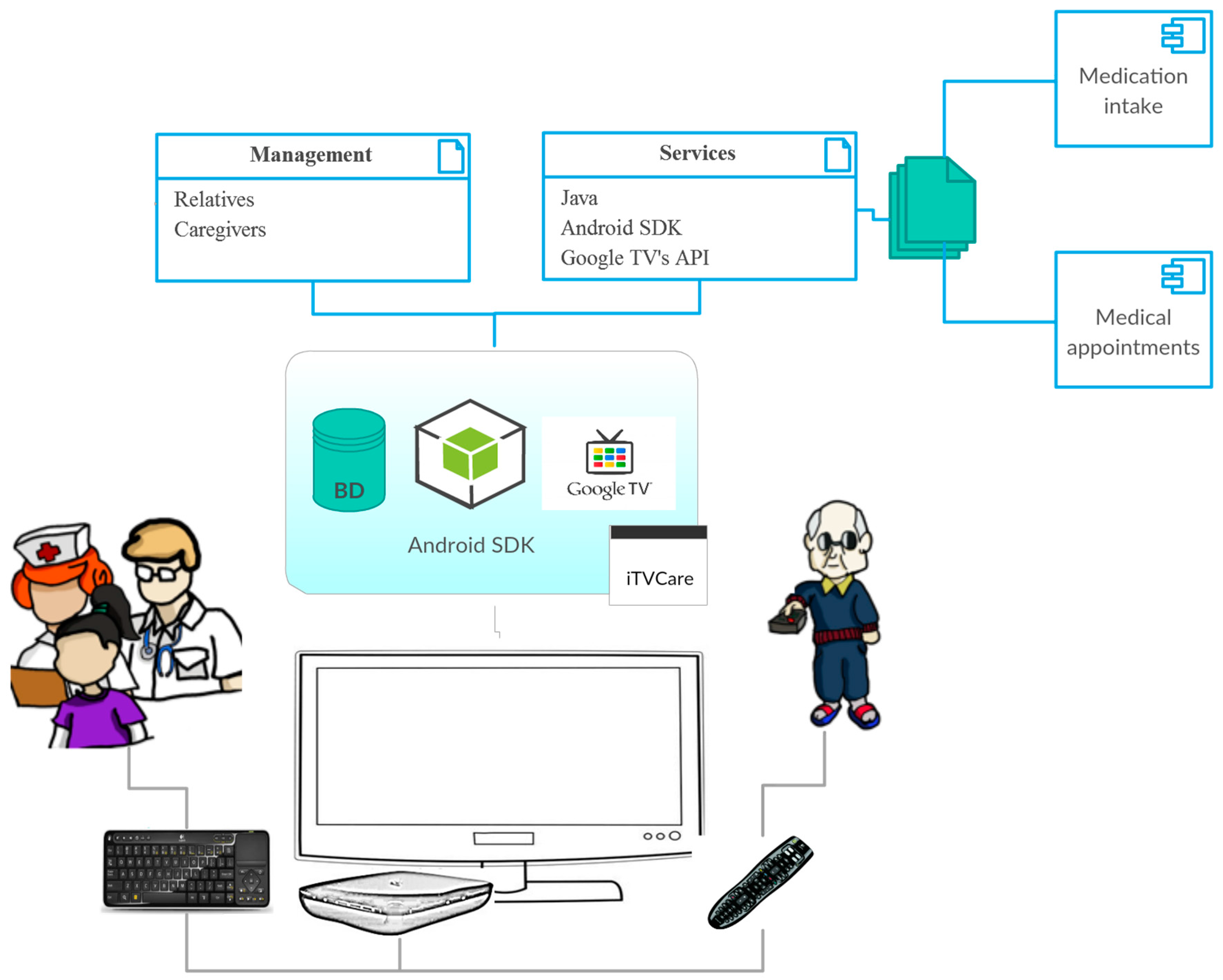
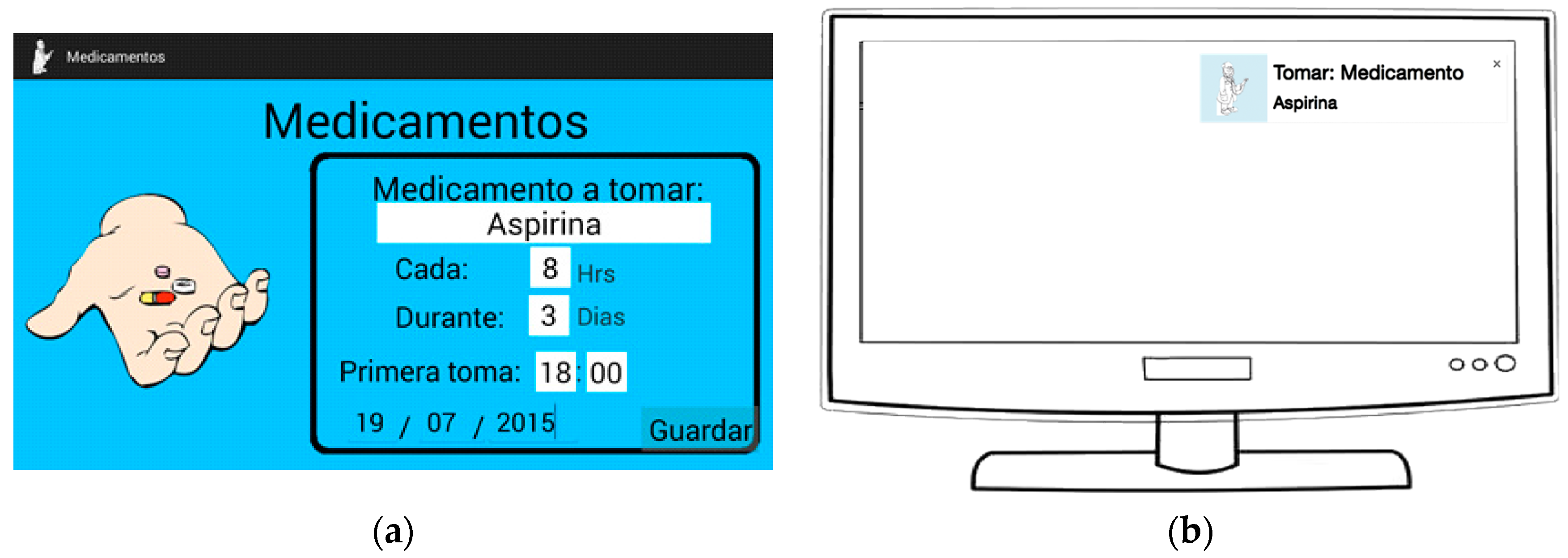
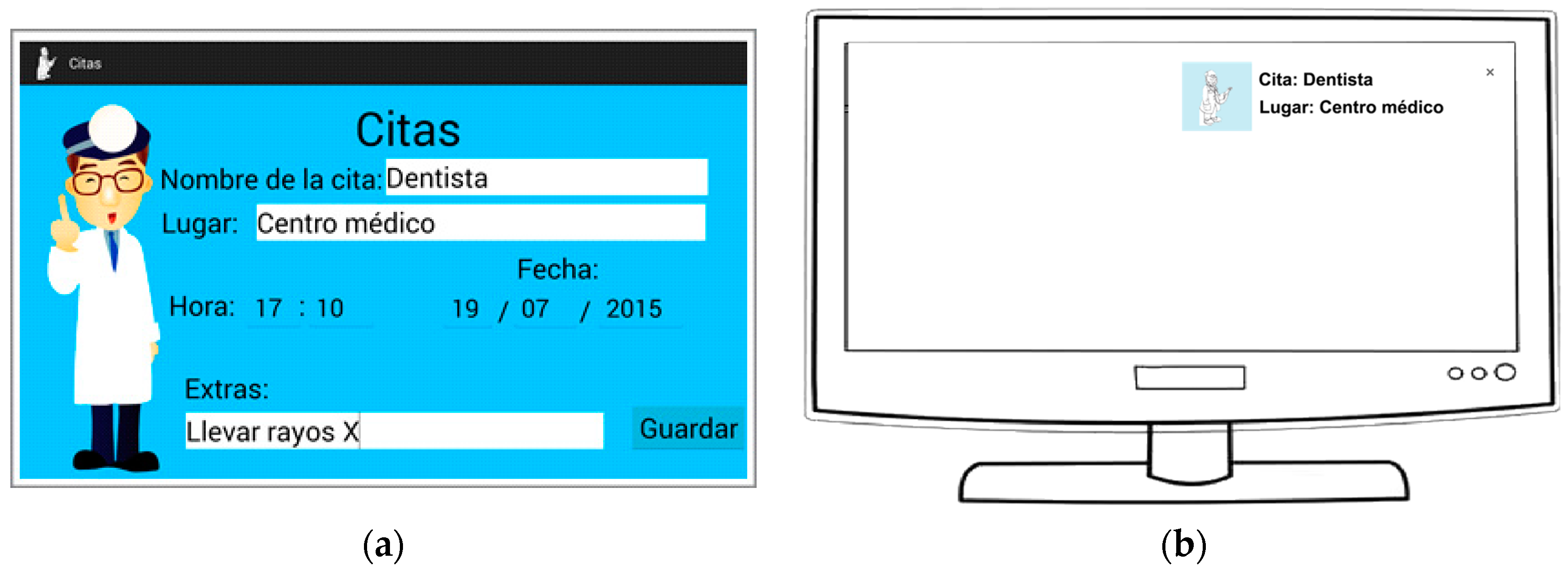
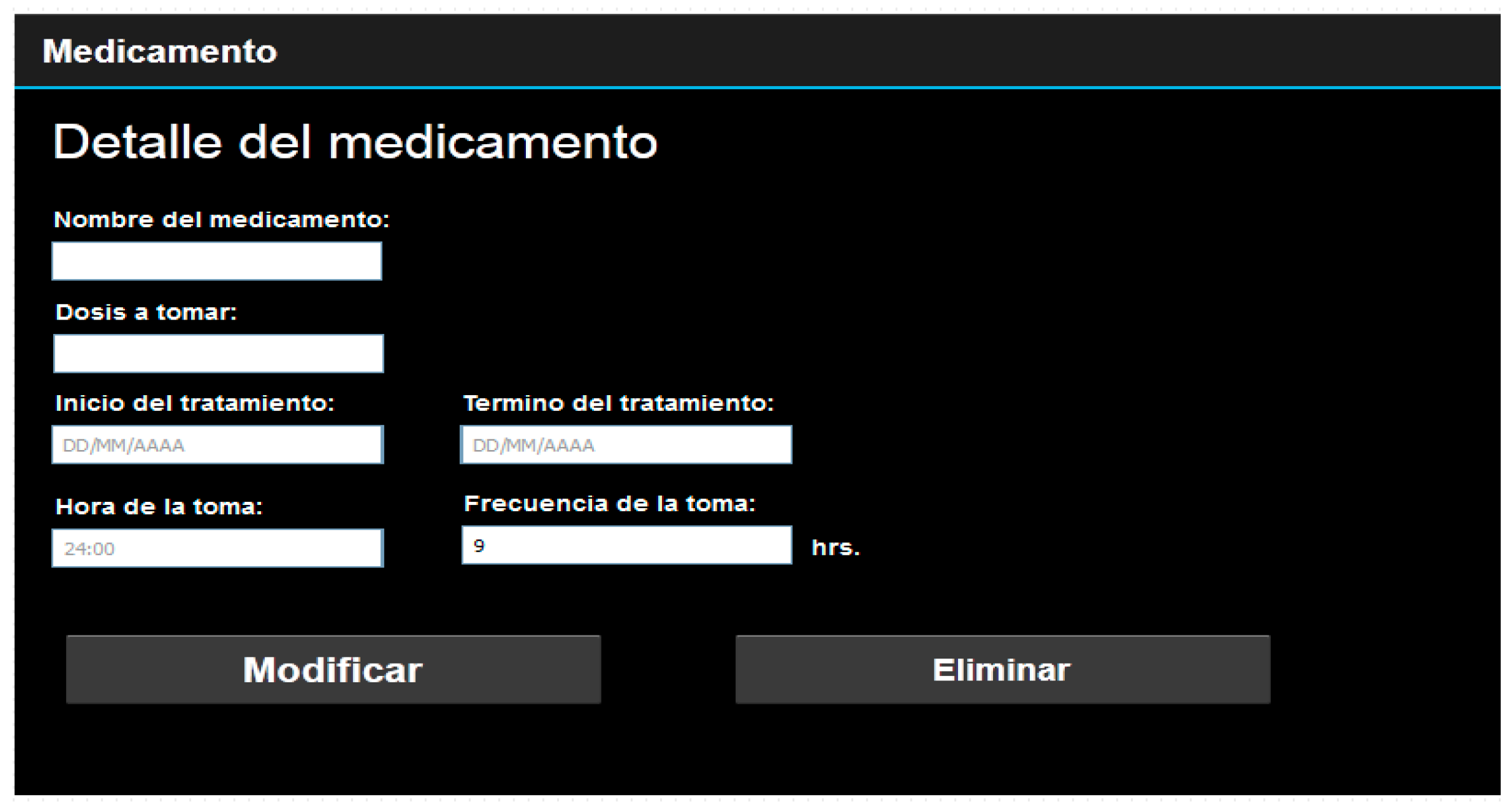
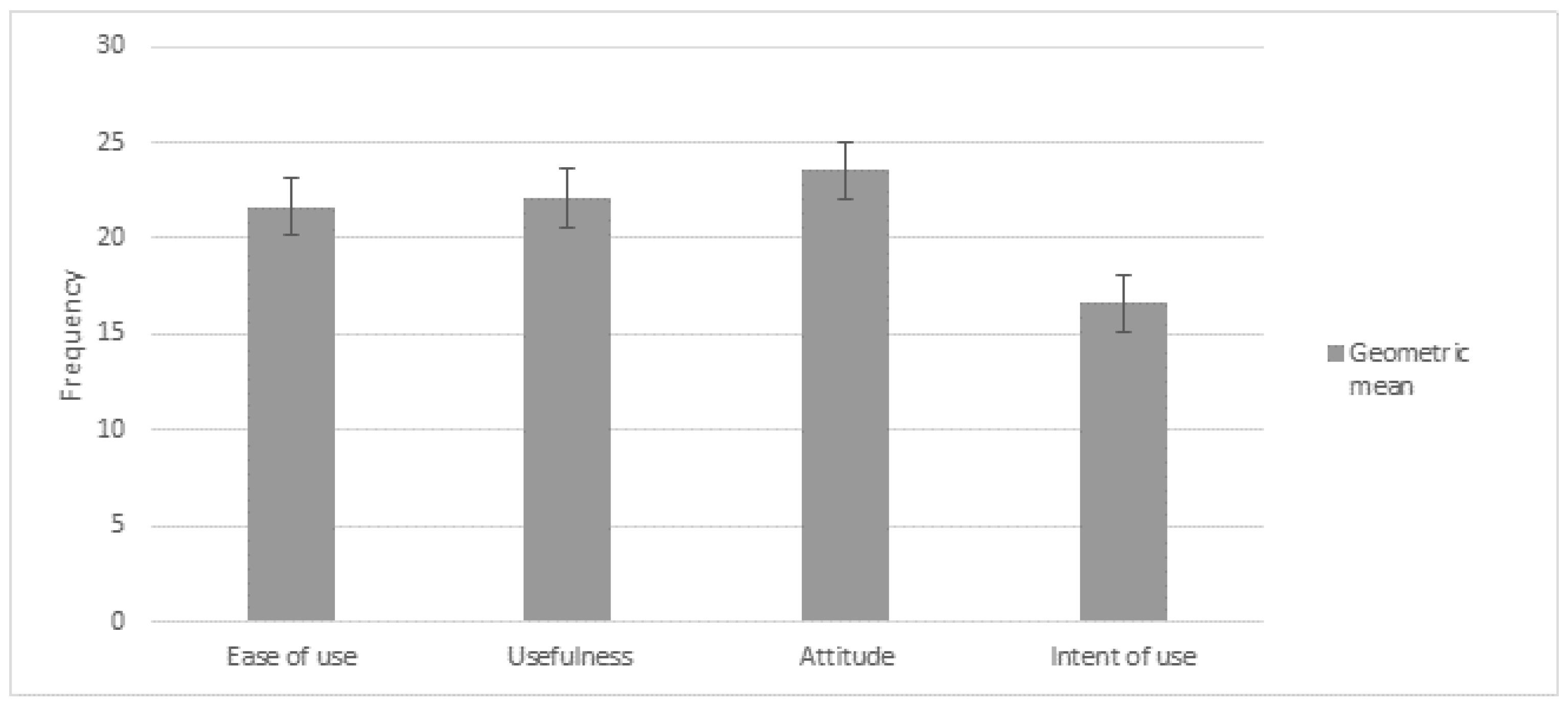
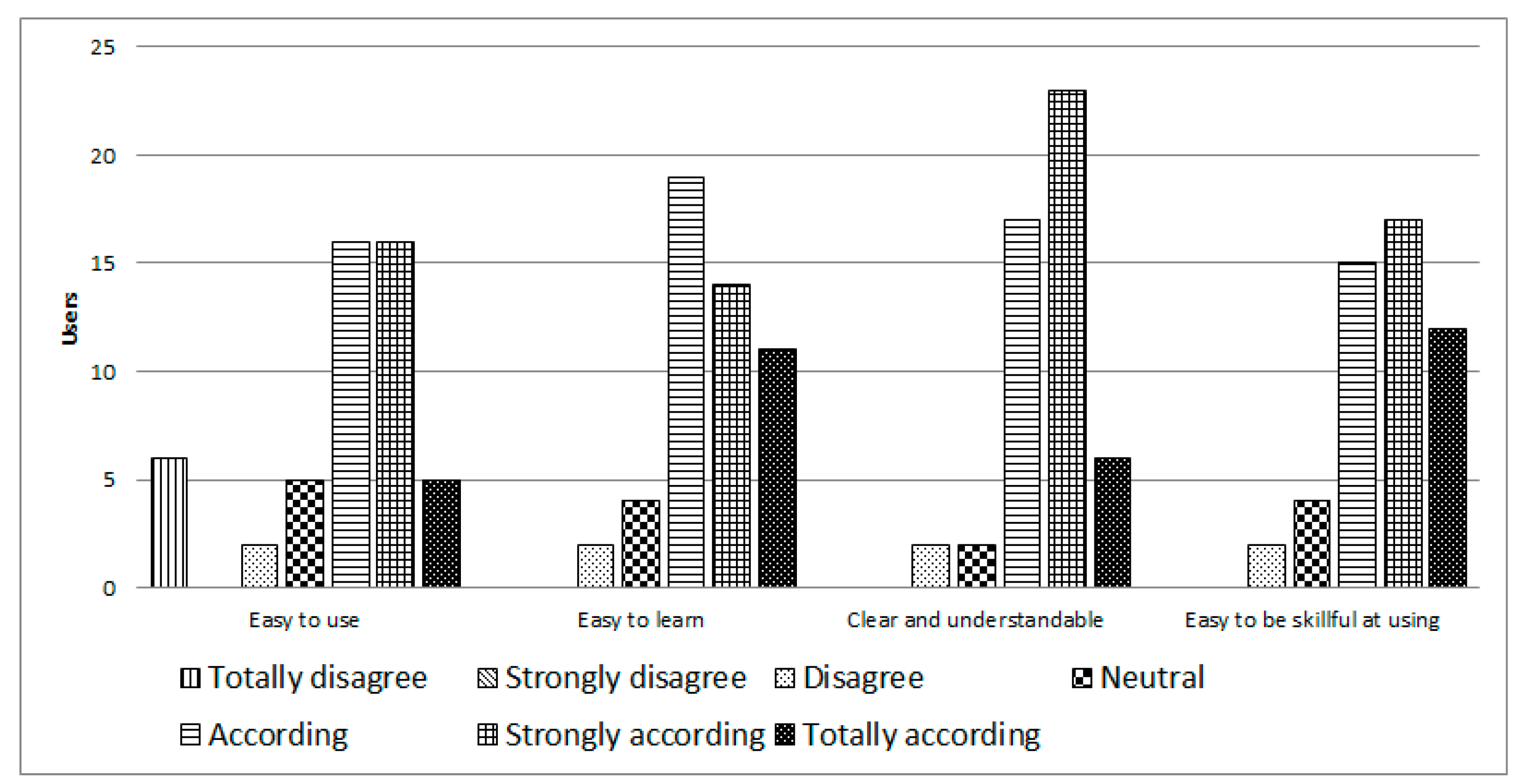
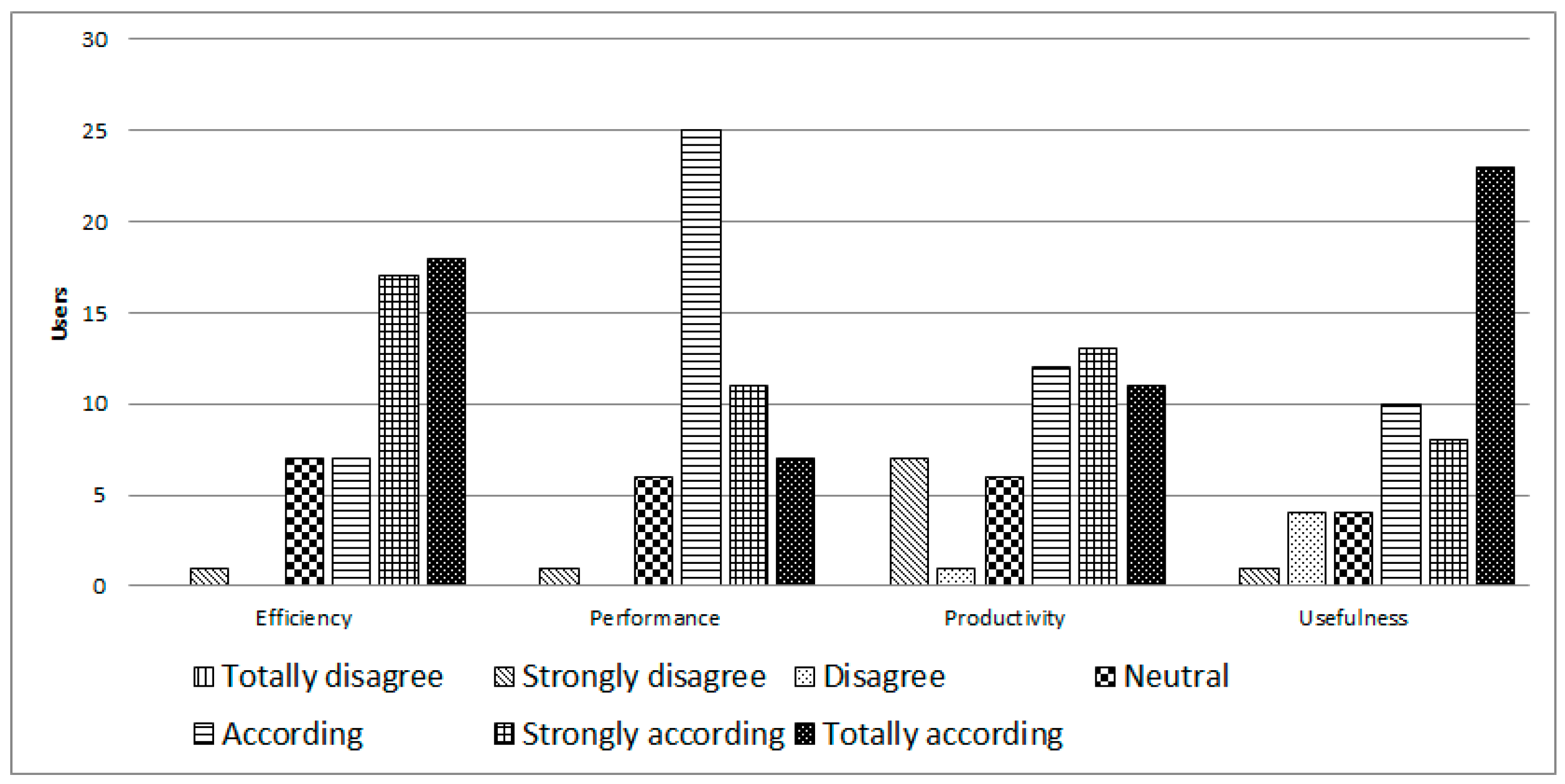
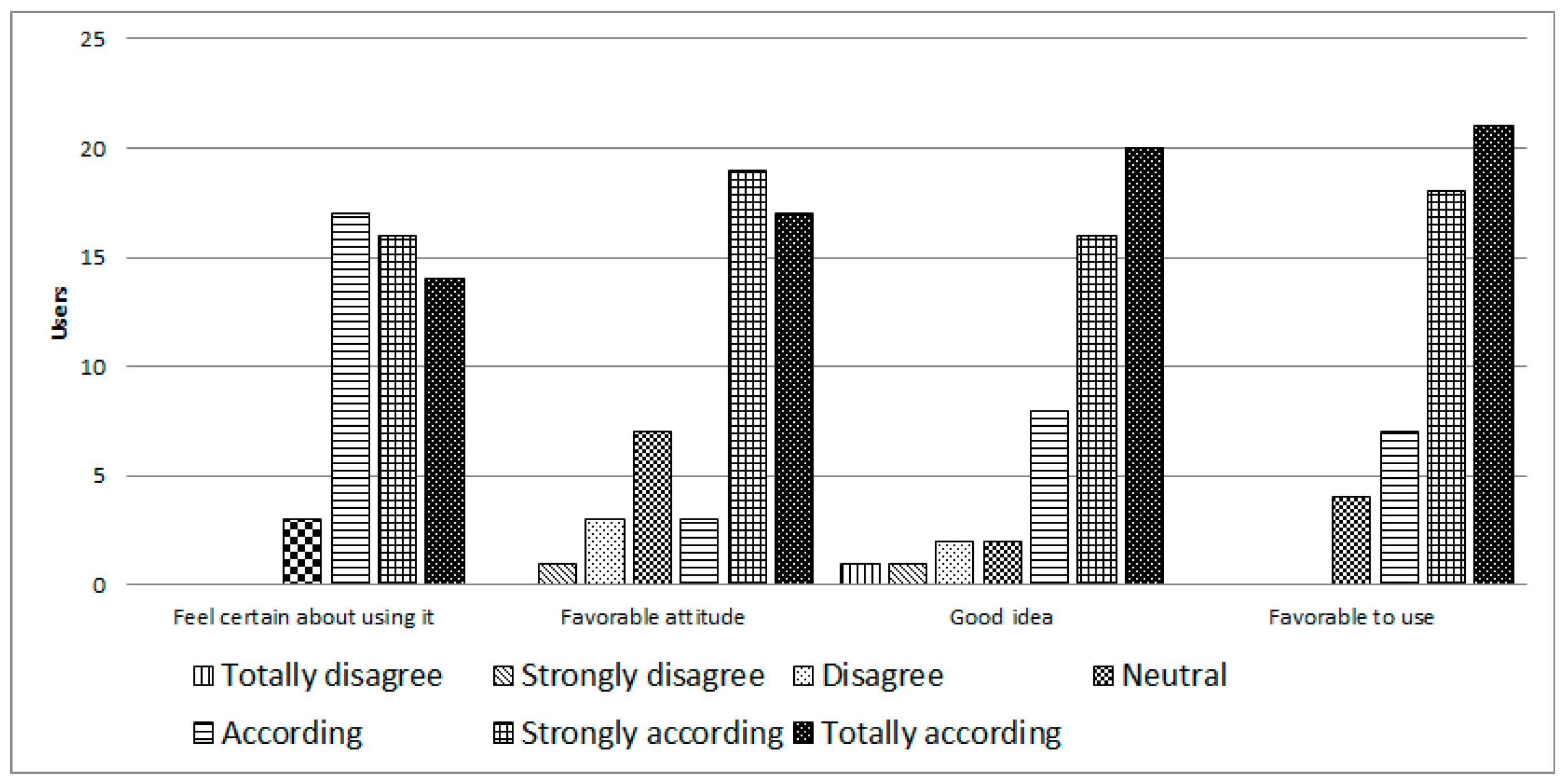
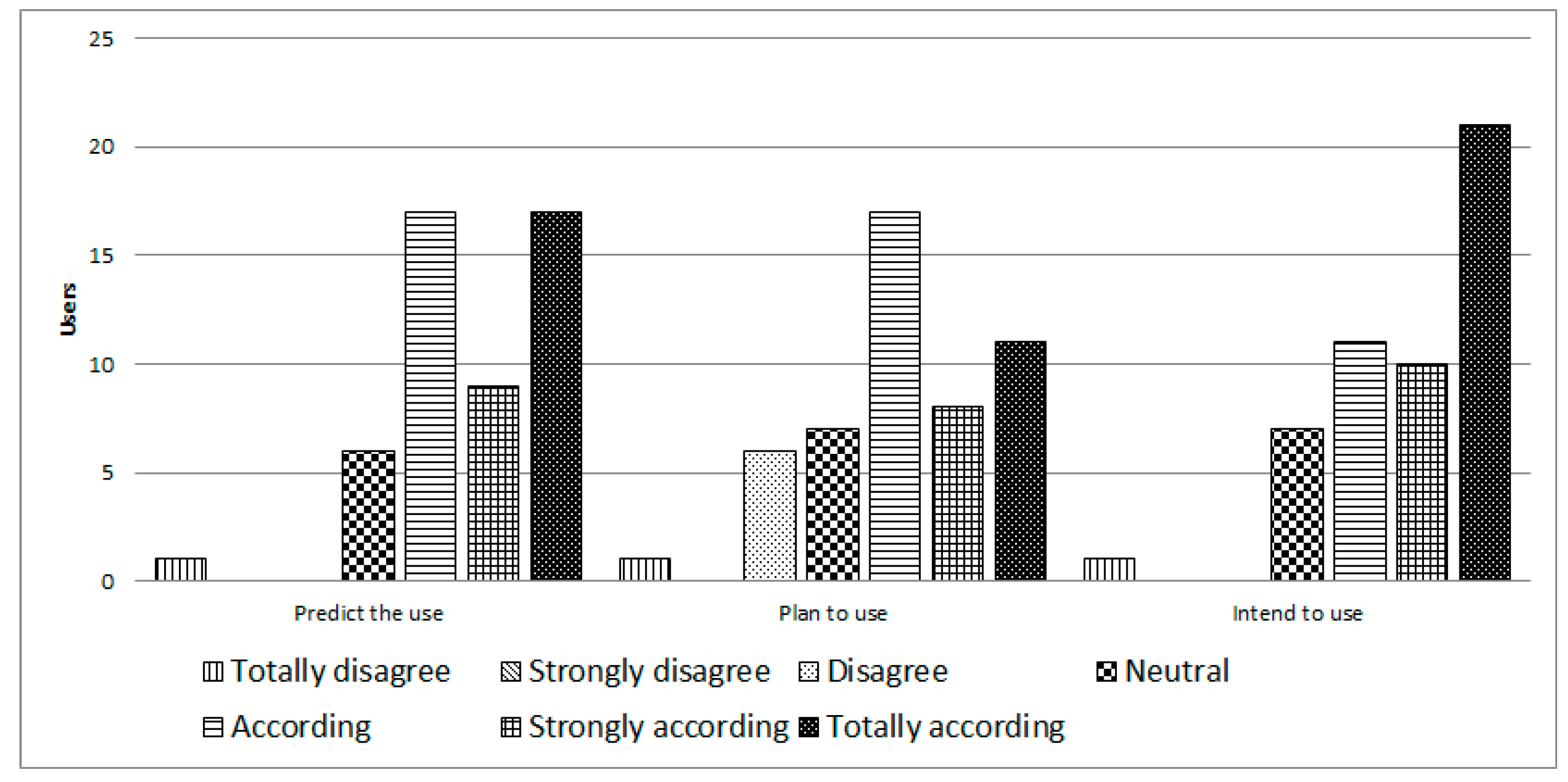
| Dimension | No. of Items | Maximum Value on Likert Scale | Expected Value |
|---|---|---|---|
| Ease of use | 4 | 28 | 25 |
| Usefulness | 4 | 28 | 25 |
| Attitude | 4 | 28 | 25 |
| Intention to use | 3 | 21 | 18 |
| Dimension | Mean | Standard Deviation | Confidence Interval | |
|---|---|---|---|---|
| Ease of use | 21.66 | 3.91 | LI = 17.74 | LS = 23.58 |
| Usefulness | 22.08 | 4.32 | LI = 19.96 | LS = 24.20 |
| Attitude | 23.56 | 3.46 | LI = 21.86 | LS = 25.26 |
| Intention to use | 16.62 | 3.44 | LI = 14.93 | LS = 18.31 |
| Dimension | Observed (O) | Expected (E) | (O−E)2 | (O−E)2/E |
|---|---|---|---|---|
| Ease of use | 21.66 | 25 | 11.16 | 0.45 |
| Usefulness | 22.08 | 25 | 8.53 | 0.34 |
| Attitude | 23.56 | 25 | 2.07 | 0.08 |
| Intention to use | 16.62 | 18 | 1.90 | 0.11 |
| Dimension | Use | Attitude | Usefulness |
|---|---|---|---|
| Attitude | 0.589 | - | - |
| Usefulness | 0.588 | 0.456 | - |
| Ease of use | 0.258 | 0.395 | 0.581 |
© 2017 by the authors. Licensee MDPI, Basel, Switzerland. This article is an open access article distributed under the terms and conditions of the Creative Commons Attribution (CC BY) license (http://creativecommons.org/licenses/by/4.0/).
Share and Cite
Santana-Mancilla, P.C.; Anido-Rifón, L.E. The Technology Acceptance of a TV Platform for the Elderly Living Alone or in Public Nursing Homes. Int. J. Environ. Res. Public Health 2017, 14, 617. https://doi.org/10.3390/ijerph14060617
Santana-Mancilla PC, Anido-Rifón LE. The Technology Acceptance of a TV Platform for the Elderly Living Alone or in Public Nursing Homes. International Journal of Environmental Research and Public Health. 2017; 14(6):617. https://doi.org/10.3390/ijerph14060617
Chicago/Turabian StyleSantana-Mancilla, Pedro C., and Luis E. Anido-Rifón. 2017. "The Technology Acceptance of a TV Platform for the Elderly Living Alone or in Public Nursing Homes" International Journal of Environmental Research and Public Health 14, no. 6: 617. https://doi.org/10.3390/ijerph14060617
APA StyleSantana-Mancilla, P. C., & Anido-Rifón, L. E. (2017). The Technology Acceptance of a TV Platform for the Elderly Living Alone or in Public Nursing Homes. International Journal of Environmental Research and Public Health, 14(6), 617. https://doi.org/10.3390/ijerph14060617







